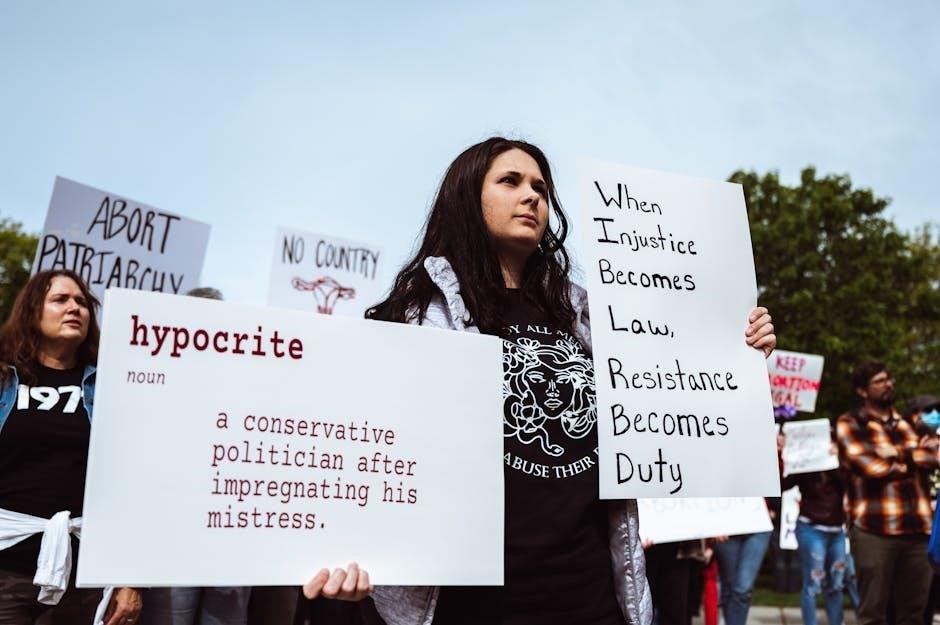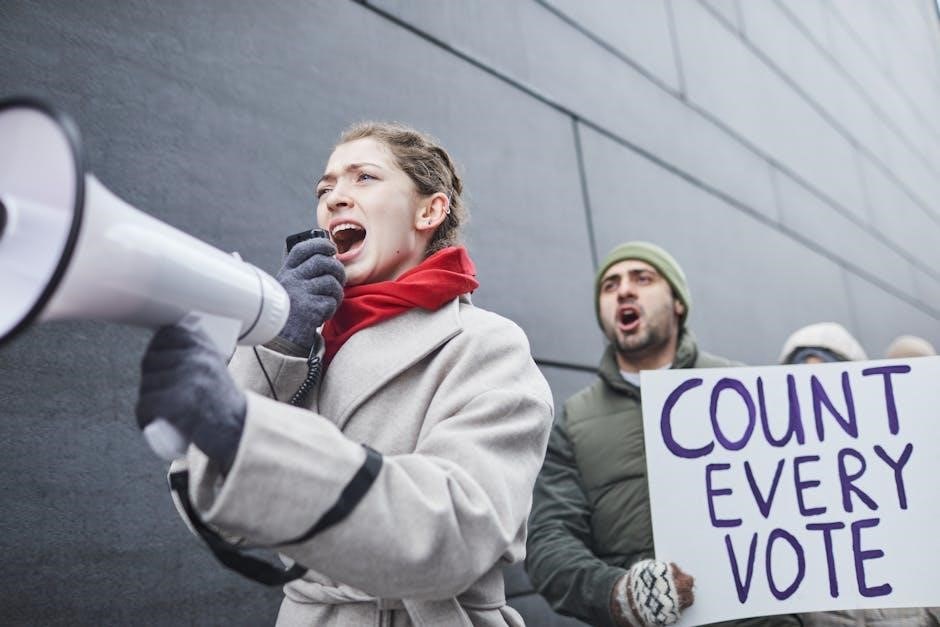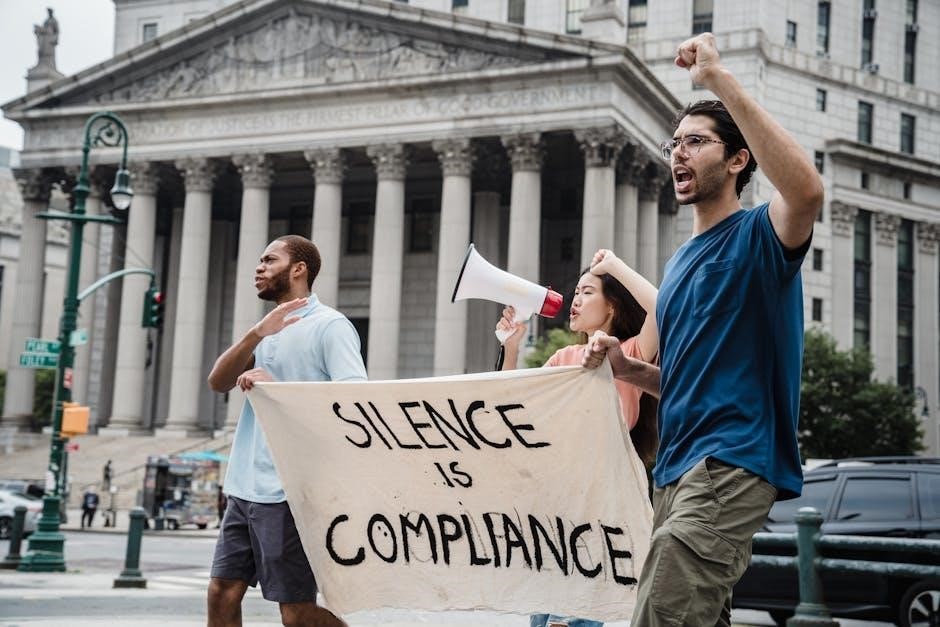The Four Freedoms Speech‚ delivered by Franklin D. Roosevelt on January 6‚ 1941‚ outlined four essential human rights: freedom of speech‚ worship‚ freedom from want‚ and fear. It is available as a PDF for free download‚ providing insights into its historical significance and vision for a post-war world.
1.1 Overview of the Four Freedoms Speech

The Four Freedoms Speech‚ delivered by President Franklin D. Roosevelt on January 6‚ 1941‚ is one of the most iconic addresses in American history. It was part of his State of the Union speech to Congress‚ emphasizing four fundamental freedoms that should be universally protected: freedom of speech‚ freedom of worship‚ freedom from want‚ and freedom from fear. Roosevelt argued that these freedoms were essential for a secure and just world‚ urging Americans to support democracy and oppose tyranny. The speech not only shaped U.S. foreign policy but also inspired global efforts to promote human rights. It is widely regarded as a defining moment in the lead-up to World War II‚ as it rallied support for the Allied cause. The speech’s vision influenced the creation of the United Nations and remains a cornerstone of democratic ideals. Its full text is available online in PDF format for educational and historical reference.
1.2 Historical Significance of the Speech
The Four Freedoms Speech‚ delivered by Franklin D. Roosevelt in January 1941‚ holds profound historical significance as a call to action for democracy and human rights. It marked a turning point in U.S. foreign policy‚ shifting the nation from isolationism to global engagement. The speech’s emphasis on freedom of speech‚ worship‚ from want‚ and from fear inspired a vision for a post-war world founded on justice and security. It rallied American support for the Allied cause in World War II and laid the groundwork for the creation of the United Nations. The speech’s ideals influenced the Universal Declaration of Human Rights and continue to shape global discussions on liberty and dignity. Historians and scholars study the address for its rhetorical power and its role in redefining America’s role on the world stage. Its legacy endures as a cornerstone of democratic values‚ reminding future generations of the importance of protecting fundamental freedoms.
1.3 Availability of the Speech in PDF Format
The Four Freedoms Speech is widely available in PDF format for free download‚ enabling easy access to Roosevelt’s historic address. This accessibility ensures that the speech’s enduring message of freedom and democracy can be studied and appreciated by individuals worldwide. The PDF version preserves the original text’s integrity‚ allowing readers to engage with Roosevelt’s visionary language and the historical context of his address. Many educational and historical websites offer the speech in PDF format‚ making it a valuable resource for students‚ researchers‚ and history enthusiasts. Additionally‚ the PDF version is often accompanied by supplementary materials‚ such as historical context‚ analysis‚ and related documents‚ enhancing its educational value. The widespread availability of the Four Freedoms Speech in PDF underscores its lasting relevance and the importance of its message in contemporary discussions of liberty and human rights.
Historical Context of the Four Freedoms Speech
Delivered in 1941‚ the Four Freedoms Speech occurred amidst global turmoil‚ as World War II raged and the U.S. debated its role in international affairs. Roosevelt aimed to inspire support for democracy and shift America’s isolationist stance.

2.1 The Global Situation in 1941
In 1941‚ the world was deeply embroiled in World War II‚ with Axis powers dominating Europe‚ Asia‚ and Africa. Nazi Germany controlled much of Europe‚ while Imperial Japan expanded its influence in East Asia. The global conflict had created widespread instability‚ displacement‚ and human suffering. Democracies like the United Kingdom were under constant threat‚ and the need for international cooperation to counter aggression became urgent. The United States‚ though still maintaining its isolationist policies‚ was increasingly pressured to support Allied nations. This precarious global environment shaped Roosevelt’s vision‚ as he sought to rally Americans behind a cause that transcended national interests‚ emphasizing the importance of defending democratic values and human rights. The Four Freedoms Speech was a direct response to this volatile situation‚ offering a hopeful vision for a post-war world founded on freedom and security.
2.2 The United States’ Isolationist Policies
Prior to World War II‚ the United States adhered to a policy of isolationism‚ avoiding involvement in European and Asian conflicts. This stance was rooted in historical practices‚ including the Monroe Doctrine and the desire to focus on domestic recovery during the Great Depression. The Neutrality Acts of the 1930s further solidified this position‚ restricting American involvement in foreign wars. Public sentiment leaned heavily toward non-interventionism‚ with many Americans viewing World War I as a costly and futile endeavor. However‚ as global tensions escalated and Axis aggression intensified‚ President Roosevelt recognized the need to challenge this isolationist mindset. His Four Freedoms Speech served as a call to action‚ urging Americans to support democratic nations and prepare for potential threats to national security. This shift marked a turning point in U.S. foreign policy‚ as the nation gradually moved from isolationism to international engagement.
2.3 Roosevelt’s Vision for a Post-War World

In his Four Freedoms Speech‚ Roosevelt articulated a visionary framework for a post-World War II world‚ emphasizing global collaboration and the protection of fundamental human rights. He advocated for a world where all people could enjoy freedom of speech‚ worship‚ freedom from want‚ and freedom from fear. This vision transcended national boundaries‚ calling for collective action to ensure peace and security. Roosevelt’s speech reflected his belief in a new international order‚ where nations would work together to prevent future conflicts and promote economic and social well-being. By framing the war as a struggle for universal liberties‚ he aimed to inspire hope and unity among Americans and the global community. This vision later influenced the establishment of the United Nations and shaped U.S. foreign policy‚ marking a significant shift from isolationism to international leadership.
The Four Freedoms Speech: Key Elements
The speech defined four freedoms: freedom of speech‚ worship‚ from want‚ and fear. It emphasized universal human rights and structured a moral framework for U.S. involvement in WWII‚ inspiring global unity and hope.
3.1 Freedom of Speech and Expression
Freedom of speech and expression was the first of the four freedoms Roosevelt highlighted. He envisioned a world where individuals could express their opinions without fear of censorship or retribution‚ anywhere in the world. This principle was central to his argument for defending democracy and combating tyranny. Roosevelt emphasized that this freedom was not limited to Americans but should be universal‚ ensuring that everyone could voice their thoughts freely. By prioritizing this freedom‚ he aimed to inspire global unity and resistance against oppressive regimes. The inclusion of freedom of speech in the Four Freedoms speech underscored its importance as a cornerstone of democratic values and human rights. This ideal continues to resonate today‚ influencing modern discussions on free expression and its role in maintaining open societies.

3.2 Freedom of Worship
Freedom of worship was the second freedom highlighted by Roosevelt in his 1941 speech. He envisioned a world where every individual could worship God in their own way‚ free from persecution or restriction. This principle underscored the importance of religious tolerance and the right to practice one’s faith without fear of reprisal. Roosevelt emphasized that this freedom should be universal‚ applying to all people everywhere in the world. By advocating for freedom of worship‚ he sought to promote a global society where diversity of belief was respected and protected. This ideal was central to his vision of a post-war world founded on fundamental human rights. The inclusion of freedom of worship in the Four Freedoms speech reflected Roosevelt’s commitment to combating religious oppression and fostering unity across cultures and nations. This principle remains a cornerstone of democratic values and continues to inspire efforts to protect religious freedom worldwide.
3.3 Freedom from Want

Freedom from want‚ the third freedom in Roosevelt’s speech‚ addressed the universal desire for economic security and access to basic necessities. Roosevelt envisioned a world where no person would suffer from hunger‚ poverty‚ or lack of essential resources. He emphasized the need for global cooperation to ensure that all individuals could meet their basic needs‚ thereby eliminating the conditions that breed desperation‚ conflict‚ and tyranny. This freedom was not only about ending material deprivation but also about creating opportunities for a dignified life. By advocating for freedom from want‚ Roosevelt aimed to establish a foundation for lasting peace and prosperity. The inclusion of this freedom highlighted the interconnectedness of economic well-being and global stability. It remains a powerful call to action for addressing poverty and inequality‚ inspiring initiatives to promote economic development and social justice worldwide.
3.4 Freedom from Fear
Freedom from fear‚ the fourth freedom‚ focused on eliminating the threat of aggression and ensuring global security. Roosevelt emphasized that no nation should live under the constant threat of invasion or attack. He called for a world where all peoples could live free from the fear of violence‚ oppression‚ or terrorism. This freedom was closely tied to the need for collective security and international cooperation to prevent war and protect the vulnerable. By advocating for freedom from fear‚ Roosevelt underscored the importance of creating a stable and peaceful world order. He believed that true freedom could only exist when individuals were safe from the shadow of armed conflict. This vision continues to resonate‚ inspiring efforts to promote peace‚ reduce armaments‚ and build a more just and secure international community. The PDF of the speech highlights this as a cornerstone of his vision for a post-war world.
3.5 The Structure of the Speech
The Four Freedoms Speech is structured to clearly convey Roosevelt’s vision for a post-war world. It begins with an introduction addressing the gravity of the global situation and the need for collective action. The speech then transitions into the core message‚ outlining the four freedoms: freedom of speech‚ freedom of worship‚ freedom from want‚ and freedom from fear. Each freedom is explained concisely‚ emphasizing its universal importance. The speech concludes by linking these freedoms to American values and the necessity of global security. The PDF version of the speech preserves this structure‚ making it easy to follow Roosevelt’s logical progression from the challenges of the moment to his aspirational vision for the future. This clear and organized format helped ensure the speech’s enduring impact and accessibility for readers and historians alike.
3.6 Key Themes and Messages
The Four Freedoms Speech centers on themes of democracy‚ human rights‚ and global security. Roosevelt emphasized the importance of freedom of speech‚ freedom of worship‚ freedom from want‚ and freedom from fear as universal aspirations. He framed these freedoms as essential for a just and peaceful post-war world. The speech also highlighted the need for collective action against tyranny and aggression‚ appealing to American values while urging global cooperation. Roosevelt’s message was both a call to action and a vision for a future where these freedoms could be realized worldwide. The speech’s themes of moral leadership and the protection of human dignity continue to resonate‚ influencing international policies and inspiring movements for freedom and justice. The PDF version of the speech captures these themes vividly‚ offering a timeless blueprint for a world founded on liberty and equality;

The Impact of the Four Freedoms Speech
The speech had an immediate and lasting impact‚ motivating WWII efforts and shaping global post-war policies. It influenced the United Nations Charter and inspired movements for freedom worldwide‚ leaving a enduring legacy in democracy and human rights.
4.1 Immediate Reactions to the Speech
The Four Freedoms Speech received widespread attention and sparked immediate reactions across the United States and globally. Many in Congress and the American public viewed it as a call to action‚ urging support for democratic values amid rising global tensions. The speech resonated deeply‚ as it framed World War II not just as a military conflict but as a struggle for fundamental human rights. Media outlets praised Roosevelt’s vision‚ emphasizing its relevance to the global crisis. The speech also gained traction internationally‚ inspiring hope among those living under oppressive regimes. Its message of freedom and democracy became a rallying cry‚ influencing public opinion and policy decisions. The immediate reactions highlighted the speech’s power to unite and motivate‚ setting the stage for its enduring impact on American foreign policy and global relations. The Four Freedoms speech PDF remains a testament to its lasting influence‚ offering insights into its historical significance and timeless ideals.
4.2 The Speech’s Role in WWII
The Four Freedoms Speech played a pivotal role in World War II by redefining the Allied mission and inspiring collective action. Roosevelt’s vision of a world based on freedom of speech‚ worship‚ freedom from want‚ and fear resonated globally‚ uniting nations against tyranny. The speech mobilized American support for entering the war‚ shifting public opinion from isolationism to interventionism. It also shaped the war’s objectives‚ emphasizing the fight for democracy and human rights. The ideals expressed in the speech influenced post-war planning‚ contributing to the establishment of the United Nations and its commitment to global security and cooperation. Available as a PDF‚ the speech remains a powerful document‚ illustrating its role in galvanizing the Allied effort and shaping the course of modern history. Its impact on WWII was profound‚ as it not only motivated soldiers but also provided a moral framework for the war’s outcome‚ ensuring its legacy endures as a cornerstone of freedom and democracy.
4.3 Influence on the United Nations Charter
The Four Freedoms Speech significantly influenced the creation of the United Nations Charter‚ shaping its core principles. Roosevelt’s vision of a world founded on freedom of speech‚ worship‚ freedom from want‚ and fear aligned with the UN’s mission to promote peace‚ security‚ and cooperation. The speech’s emphasis on universal human rights inspired the Charter’s preamble‚ which commits to saving future generations from the scourge of war and reaffirms faith in fundamental human rights. The PDF version of the speech‚ widely circulated‚ served as a blueprint for post-war international relations‚ emphasizing collective security and human dignity. Its principles are reflected in the UN’s focus on promoting social progress‚ better living standards‚ and freedom from fear and want. The speech’s legacy endures as a foundational document of the UN‚ ensuring its ideals remain central to global governance and human rights advocacy‚ as detailed in the PDF of Roosevelt’s historic address.

Legacy of the Four Freedoms Speech
The Four Freedoms Speech has left a lasting impact‚ inspiring Norman Rockwell’s illustrations and shaping global human rights ideals. Its vision of freedom continues to influence modern democracy‚ as detailed in the PDF of Roosevelt’s speech.
5;1 Enduring Relevance of the Four Freedoms
The Four Freedoms remain a cornerstone of global aspirations for democracy and human rights. Their relevance endures as they address universal values: freedom of speech‚ worship‚ freedom from want‚ and freedom from fear. These ideals‚ first articulated by Roosevelt in 1941‚ continue to inspire movements worldwide‚ emphasizing the importance of equality and security. The PDF of the speech is widely accessed‚ ensuring its message reaches new generations. It has influenced international charters and cultural works‚ such as Norman Rockwell’s iconic paintings. Today‚ the Four Freedoms are invoked in discussions on civil liberties‚ global conflict‚ and social justice‚ proving their timeless significance. Their legacy underscores the ongoing struggle for a world where these freedoms are universally upheld‚ making the speech a foundational document in the pursuit of human dignity and peace. Its enduring relevance is a testament to the power of visionary leadership and the eternal quest for freedom.
5.2 Influence on American Foreign Policy
Roosevelt’s Four Freedoms Speech significantly shaped American foreign policy‚ redefining national priorities. It shifted focus from isolationism to global engagement‚ emphasizing democracy and human rights. The speech inspired post-war initiatives like the United Nations‚ embedding its principles into international law. The PDF version highlights these ideas‚ influencing policies promoting freedom and security. It remains a blueprint for U;S. diplomacy‚ advocating for a world where these freedoms are protected. The speech’s vision continues to guide American actions‚ promoting democracy and opposing tyranny‚ ensuring its lasting impact on foreign policy.

5.3 Cultural and Artistic Representations
The Four Freedoms Speech has inspired numerous cultural and artistic works‚ cementing its place in history. Norman Rockwell’s iconic Four Freedoms paintings‚ published in 1943‚ visually captured Roosevelt’s vision‚ becoming symbols of American ideals. These artworks‚ along with the PDF versions of the speech‚ have been widely used in educational materials‚ exhibitions‚ and public displays. The speech also influenced literature‚ music‚ and film‚ with themes of freedom and democracy recurring in creative works. Its impact is evident in works like Rockwell’s Freedom from Want and Freedom of Speech‚ which continue to inspire artists and educators. These representations ensure the speech’s message endures‚ reminding future generations of its significance. The cultural legacy of the Four Freedoms Speech remains a powerful testament to its timeless ideals.
The Four Freedoms Speech is a pivotal moment in history‚ shaping WWII and inspiring the UN. Its vision of freedom remains relevant today‚ influencing both policy and culture. The PDF availability ensures its legacy endures globally.
6.1 Summary of the Speech’s Importance
The Four Freedoms Speech‚ delivered by Franklin D. Roosevelt in 1941‚ is a landmark address that defined the Allied goals for World War II and shaped the post-war world order. It emphasized four universal freedoms: freedom of speech‚ freedom of worship‚ freedom from want‚ and freedom from fear. These principles not only inspired hope during a time of global turmoil but also laid the foundation for the United Nations Charter and modern human rights frameworks. The speech reframed the war as a struggle for democracy and liberty‚ uniting Americans and the international community around a shared vision. Its enduring relevance lies in its call for a world where these freedoms are universally protected. Today‚ the speech remains a powerful symbol of democracy and is widely studied as a pivotal moment in history‚ with its full text available in PDF format for educational and historical reference.
6.2 Final Thoughts on the Four Freedoms

The Four Freedoms‚ as articulated by Roosevelt‚ transcend time and continue to resonate globally. The principles of freedom of speech‚ worship‚ and freedom from want and fear are not only ideals but essential pillars for a just society. These freedoms‚ outlined in the speech and available in PDF format‚ remind us of the enduring struggle for human dignity and democracy. They serve as a blueprint for addressing contemporary challenges‚ from inequality to authoritarianism. Roosevelt’s vision‚ while rooted in the context of World War II‚ remains a timeless call to action. The Four Freedoms inspire us to strive for a world where all individuals can live without fear‚ express their beliefs‚ and enjoy economic security. Their relevance endures‚ making the speech a cornerstone of modern human rights discourse and a testament to the power of visionary leadership.



